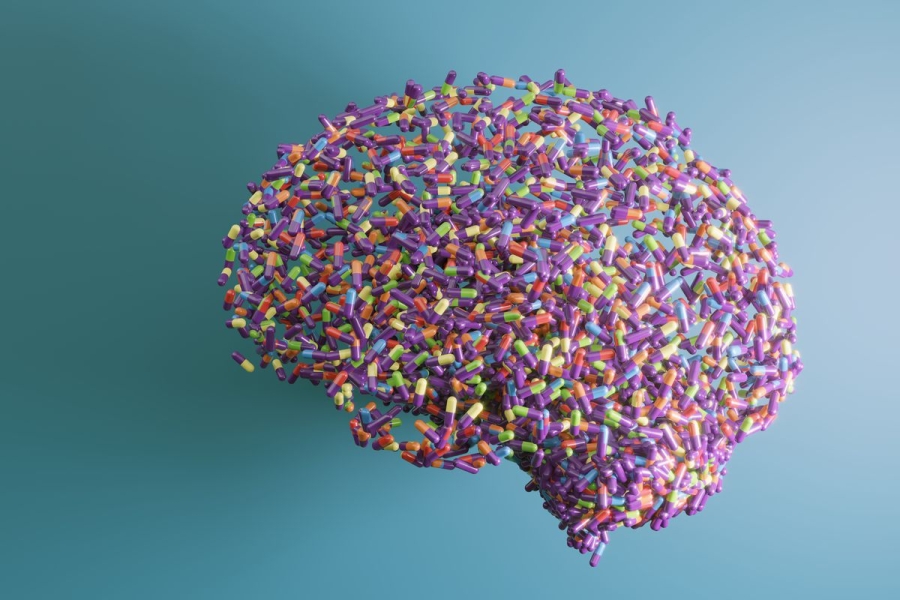Sure, Elon Musk’s into ketamine and Peter Thiel has his doping Olympics, but drugs and tech are nothing new.

Whizy Kim is a reporter covering how the world’s wealthiest people wield influence, including the policies and cultural norms they help forge. Before joining Vox, she was a senior writer at Refinery29.
Elon Musk uses drugs. So do some of the people he works with — including directors on the Tesla board — sometimes allegedly partaking with Musk. These revelations have been a minor point of scandal in the media lately, particularly after a Wall Street Journal article last year discussed how popular microdosing drugs like ketamine, LSD, and shrooms are in Silicon Valley, including among some of the most famous executives in the industry. It has become, the piece noted, “a routine part of doing business” for many. Musk has talked about having a prescription for ketamine and famously smoked a joint with Joe Rogan years ago. Peter Thiel has funded a psychedelic therapy startup and is also bankrolling a doping-friendly sports competition.
But the tech set’s fascination with drugs isn’t novel — it arguably dates back to the birth of Silicon Valley. Early experiments with psychedelics in the area helped spread interest in the drugs to a broader audience, especially as a tool to expand creative thinking abilities, and were part of a larger countercultural moment. Vox spoke to John Markoff, a longtime tech journalist and author of What the Dormouse Said: How the Sixties Counterculture Shaped the Personal Computer Industry, on how research on psychedelics in the nascent Silicon Valley overlapped with its interest in measuring creativity and exploring ideas around transhumanism. The conversation has been lightly edited for clarity.
The thrust of the recent pieces on Musk and other famous tech figures seems to be that taking psychedelics is a newer movement within Silicon Valley. But do you agree with that?
I completely disagree with that. My friends partied with Elon at Burning Man — I’ve known about the drug stuff for more than a decade. I think it’s great that the Journal finally reported it. There’s nothing new here. There’s been a community of people who’ve explored drugs in Silicon Valley going back to the roots of Silicon Valley.
Your book talks about the 1960s counterculture’s impact on Silicon Valley. How do those two things dovetail — and how are drugs involved in that?
There are a lot of people who believe you can take a psychedelic and it can make you more creative. That’s been one of the narratives in Silicon Valley for more than a decade. In the early 1960s, a small group of mostly engineers around SRI [Stanford Research Institute], Hewlett Packard, Varian, began experimenting with the drug. They believed that it enhanced creativity. They created an organization called the International Foundation for Advanced Study; it was based in Menlo Park. They took more than 300 mostly technical people — engineers, architects, people like that — through an intense [LSD] experience and tried to measure the question of creativity. They stopped in ’66, when the drug was made illegal. But that was one of the threads that led to the drug filtering into the broader community, where it became a recreational drug for my generation. One of the people who was part of that experiment was Stewart Brand. Another person was Doug Engelbart, the inventor of the mouse.
Silicon Valley began to form in the mid-’60s — it was named Silicon Valley in ’71 by journalists. There was, in that period, lots and lots of different kinds of experiments taking place around the notion of augmenting human intelligence. Everything from the religious to spiritual. People were exploring all kinds of things — and taking psychedelics was one of them.
I stumbled across the work of some social scientists at the Santa Fe Institute, which is this scientific group that explored chaos theory. Their argument was that creativity, in a sociological sense, happens on the edge of chaos — and that sort of brilliantly described what would become Silicon Valley in the mid-1960s. There were three laboratories surrounding Stanford University: [John] McCarthy’s Stanford AI Lab, Doug Engelbart’s Human Augmentation Research Center, and Xerox PARC. They were set down right in the middle of this incredibly chaotic community around Stanford. So I think that actually is a better explanation [of creativity in Silicon Valley] than some individual taking a drug and becoming creative.
[Taking psychedelics] reemerged in 2010, 2011. [James] Fadiman wrote a book that endorsed the concept of microdosing. People tend to look at people like Elon Musk or Peter Thiel and say, well, that’s Silicon Valley. I think that fundamentally misrepresents what Silicon Valley is, which if anything is about cultural diversity. Musk and Thiel are actually outliers.
I’m fascinated by how drugs play into the mythos of the Silicon Valley genius. That these people are “creating the future,” so drugs help with creativity and enhance their work. Is that something you’ve seen a lot?
I think the word “a lot,” I’m stumbling over. I have seen that. I’ve talked to some designers and engineers who actually believe that it helps them, but then, I’ve also talked to some journalists who believe that it helps them. I don’t think I’ve seen anything but anecdotal information. There’s Burning Man, but Burning Man is so much broader, in terms of who goes. There’s a group of technologists and entrepreneurs who have always been part of the Burning Man thing, but it’s not limited to Silicon Valley.
What comes to mind for me is Peter Thiel backing a “futuristic” sports org called the Enhanced Games. Basically, they think athletes using performance-enhancing drugs should be fair game, because it’s just elevating humanity to its full potential. It sounded like an extension of the biohacking movement, which I found interesting.
I agree with that. “Interesting” — I would use that word to describe that. That’s also true in this community around the AI movement, who believe that we’re a step away from the singularity and that somehow you can use this to transform humanity. The transhumanist movement sort of fits adjacent to that. I’ve watched bicycle racing for a long time; they’ve been using drugs in all kinds of sports for a long time. News at 11! So someone wants to put a wrapper around it and make it a positive instead of a negative, and they can get away with it.
So is there a thread from the 1960s counterculture you talk about in your book all the way to transhumanism today?
I think there are some links — the counterculture that grew out of things like the Whole Earth Catalog. Stewart Brand’s notion that “we are as gods and might as well get good at it” had that kind of aura to it. There were digital utopians in the ’60s and ’70s, and Brand represented that. The Whole Earth Catalog was a very technologically optimistic publication that captured part of the counterculture. There was this notion that we were tool users, and that computers were a universal tool. There were two laboratories on either side of the Stanford campus: John McCarthy, who coined the term “artificial intelligence,” thought it would take a decade to create a thinking machine. That was using technology to replace humans. And on the other side of the campus there was Engelbart’s lab — the same year, he coined the term “intelligence augmentation,” the notion of extending humans. It’s a super interesting dichotomy that’s defined the computer industry ever since.
It also provides a narrative for why people in tech gravitate toward drugs. When I read many of the pieces out there about tech employees who microdose, or “macrodose” — that’s what they call just a full, normal dose — often it just sounds like they’re overworked, overstressed, burned out. Those are far more quotidian reasons why people might turn to drugs, more so than “Hey, I’m inventing a new world and I need to be at my max performance.”
You can imagine them using the first part of that argument to justify their behavior, if you want an excuse to take drugs. It’s a good rationale. But once again, if you look at the demographic view of communities, you’ll realize that this is a multicultural, multinational place. If you go to any of the communities in Silicon Valley, the majority of people are foreign born. I think that’s the actual best explanation of Silicon Valley, and not actually drug-enhanced creativity.
Yeah, and I don’t even think drug usage is some central part of Silicon Valley. It just seems like a lot of attention is paid to it, and I wonder how accurate that framing is.
Yeah, I think it’s inaccurate. I think Steve Jobs had a reality distortion effect — I was the person who Jobs told that LSD was one of the two or three most significant things he had done in his life. But I wouldn’t call Jobs a drug abuser. He had an experiment with it at various times.
Do you think Silicon Valley is still part of the counterculture, or heavily influenced by a counterculture?
No. I think there are threads of the counterculture that still exist in Silicon Valley — sort of a worldview that some people have. But the counterculture is something that existed on the midpeninsula and then ultimately globally in the 1960s and 1970s. But then it got co-opted. Many of the ideas that came from the counterculture became part of the mainstream culture.
There were digital utopians in the 1960s, and then in the 1980s, something very different happened. I would call these people digital libertarians — the PayPal mafia. Musk, Thiel, et al. had a very different value set. If you want to capture Silicon Valley in its purest form, I would look at Apple and the fact that it was created by Steve Jobs and Steve Wozniak, who had very different motivations at the start of Apple Computer: Wozniak simply wanted to design a computer to share with his friends. He didn’t want to start a company; he worked for Hewlett Packard. It was Jobs who understood that there was a market, and it was that combination of the two that best expresses Silicon Valley — the hacker ethic and that entrepreneurial zeal. It dialed in the wrong direction with the rise of the PayPal mafia. Greed has come to dominate and become the defining value.
It seems like rather than any counterculture, it’s more of a contrarianism, especially with figures like Thiel.
I don’t begin to understand Thiel. He grew out of this libertarian philosophy, and I don’t think that libertarianism is a mainstream perspective in Silicon Valley. If you go around and look at the nitty-gritty of Silicon Valley, it’s a very progressive part of the world — look at how people vote. Thiel’s an outlier. It gets a lot of attention because he’s a capitalist.
Source: vox.com






